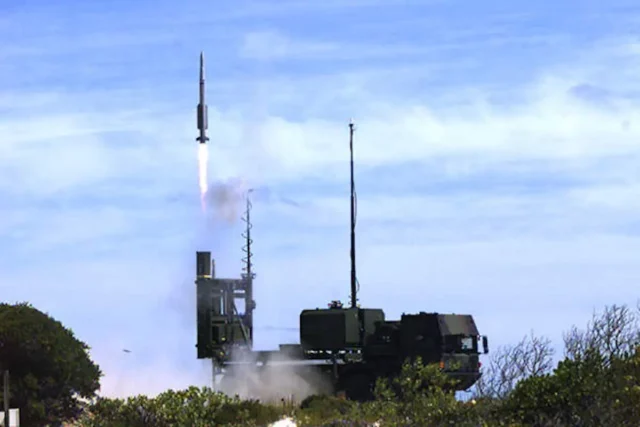
Latvia and Estonia Agree to Joint Acquisition of IRIS-T Air Defense Systems
Publication: Eurasia Daily Monitor Volume: 20 Issue: 99
By:

Latvia, together with Estonia, is undertaking the largest military procurement project since the restoration of independence in acquiring the IRIS-T air defense system from Germany. In late May 2023, these plans were made public by Latvian Minister of Defense Ināra Mūrniece and Estonian Minister of Defense Hanno Pevkur, characterizing it as an integral piece in “creating a new Livonian shield” for the protection of Latvia’s and Estonia’s airspace. Lithuania did not join the project as previously it decided to go with the United States–manufactured NASAMS air defense system (Tv3.lv, May 21).
The IRIS-T air defense system is one of the most advanced medium-range systems in the world. And it has proven itself militarily in Ukraine, ensuring 98- to 99-percent efficiency in intercepting Russian missiles (EurAsian Times, May 4). In a wider context, the so-called “Livonian shield” envisages employing air defense systems of different ranges, which would not only protect objects in the immediate vicinity but also other objects located in the wider geographic area, with each subsequent layer increasing the resilience of all systems against potential Russian military action.
Until now, the Latvian National Armed Forces have mostly developed close-range air defense capabilities. Thanks to these developments, Latvia and Estonia are taking the next step in purchasing a medium-range air defense system that will be able to protect all of Latvian and Estonian territory, as well as critical civilian and military infrastructure. Officials from the Latvian and Estonian ministries of defense are certain that the selected system provides a reliable, battle-proven solution. In this, Latvian defense officials have paid special attention to the effectiveness of anti-aircraft defense systems in real wartime conditions. “As our Ukrainian allies have confirmed, these systems are very effective against Russian weapons systems,” emphasized Mūrniece (Tv3.lv, May 21).
Yet, as a medium-range air defense system, the IRIS-T has its own weaknesses against more powerful arms. The commander of the Latvian National Armed Forces, Lieutenant General Leonids Kalniņš, noted that this air defense system will be powerless against Russia’s celebrated Kinzhal hypersonic missiles and that this particular threat requires a more powerful antidote—namely, the US-made MIM-104 Patriot system. In turn, the IRIS-T system is capable of destroying combat aircraft, helicopters, drones, cruise missiles, as well as short-range ballistic missiles (Sargs.lv, May 21).
Last year, during the NATO summit in Madrid, Latvia and Estonia signed a letter of intent for the purchase of medium-range air defense systems. It was previously reported that 600 million euros ($654.55 million) would be devoted to the purchase of these systems (Baltic Times, May 22).
As Pevkur pointed out, an international procurement search was held to choose the best possible option for the defense of Latvia’s and Estonia’s airspace. The final decision on purchasing the IRIS-T was determined by the effectiveness and price of the system. “As a result, this project is an unprecedented success story of defense cooperation between Estonia and Latvia. It is also the largest joint procurement of Estonia and Latvia in history,” said the Estonian defense minister in Riga (Sargs,lv, May 21).
According to the Latvian Ministry of Defense, the selection of the IRIS-T is an important strategic step for both Latvia and the North Atlantic Treaty Organization (NATO), as it is compatible with other widely used NATO air defense and command systems. On this, Mūrniee emphasized that Russia’s invasion of Ukraine clearly indicates the need to construct a more modern and effective air defense system in the Baltic states and surrounding region. According to the Latvian defense minister, “Fighter jets, helicopters, drones and cruise missiles are [all] capable of destroying short-range ballistic missiles,” and this is a priority for Baltic air defense.
The purchase of the IRIS-T systems will be worth hundreds of millions of euros, and negotiations are currently underway with the German supplier, Diehl Defence. If the negotiations go well, the plan is to have the contract signed by July 2023. After the conclusion of the contract, the systems could be delivered as early as 2025. Until then, Latvia and Estonia still have extensive work to complete in training personnel, improving infrastructure, as well as other considerations, so that when these systems are delivered, both countries’ armed forces will be ready to fully use and maintain them (Tv3.lv, May 21).
Currently, the Latvian Ministry of Defense is overseeing three missile system projects, the progress of which must be accelerated to strengthen national defense. These include developing stronger coastal defense against ships, medium-range air defense systems and rocket artillery. Overall, the joint procurement of the IRIS-T will allow both Latvia and Estonia to reach these goals, save money and facilitate mutual coordination in defending the Baltic Sea region (Sargs.lv, May 21).
The Kremlin’s aggressive war against Ukraine has shown that Russia’s neighbors must always be ready to defend themselves by any means possible. Latvia’s and Estonia’s joint procurement, in truth, came about as a result of the fighting in Ukraine, which has demonstrated the supremacy of air power and defense. As a result, these considerations have become top priorities for the Baltic governments in defending against Russia and other outside threats in the region.



